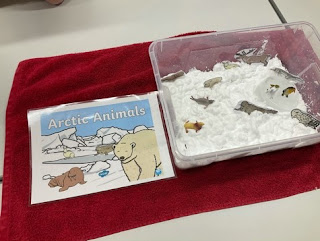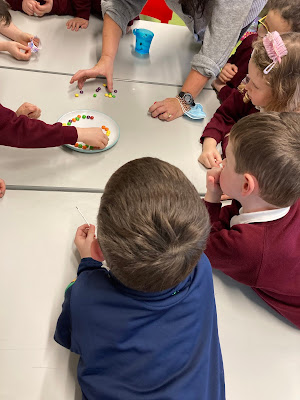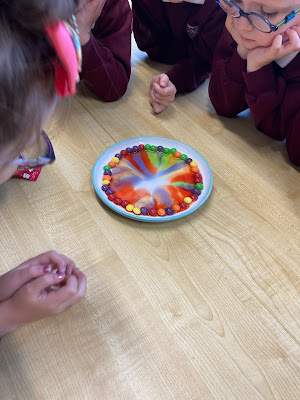STEP 1 - SCIENCE
Living Things: North Pole
Ms. Beecher’s Class visited the North Pole!
Pupils in Ms. Beecher’s Class experienced
some of the cold of the Arctic, by making an iceberg and snow during messy
play. The children listened to the story Save
the Arctic by Bethany Stahl. The story explored how the Arctic is changing
and how we need to make changes to ensure the animals survive. Pupils explored the
iceberg (ice) and snow (shaving foam) and the animals living in the Arctic.
These included the walrus, pelican, seals, reindeer, wolves and polar bears
We learned about the importance of keeping our school and play places clean. We appreciate that we have a very important role in taking care of the environment around us. We know that we share our environment with lots of plants and animals and we understand that littering and not cleaning up after ourselves may cause harm to them. We went on a clean up operation, picking up any litter that we found in our yard.
The children created a simple electrical circuit. They used a battery, wires, electrical clips and bulbs to create the circuit. They had to construct the circuit in the correct manner in order for the current to flow through the circuit and in turn cause the bulb to light up. They also used the circuit to test the conductivity of a range of materials.
Maths Questions that were discussed.
1) Would the length of leads/wires used affect the circuit? Calculate the voltage of the current by increasing or decreasing the amount of batteries used in the circuit.
Mr Faherty's 5th and 6th class really enjoyed learning about and creating circuits, it was great fun!
Miss Meaney's class really enjoyed learning about and constructing houses!
Science Investigation | Teacher Led 1. Teach the different type of houses – cdn to label the pictures correctly. 2. (Twinkl powerpoint) 3. Talk about what it is like to be homeless. Talk about items that we want/need if we had to move out of our house.
| Matching, labelling, investigation skills, prediction. | Can children understand that some people do not have a home of their own. Be able to identify items that we need/want. | Explore with me. |
Arts and crafts | Cdn to create their own house, using a range of art materials. They must cut out a range of shapes, including 2 D shapes.
| Visual arts – cutting and sticking. Maths – 2D shapes | Can cdn use materials to create a shape like a house? | Selection of art materials, glue, scissors. |
Materials - Ms Beecher's Class
The children made soup to mark Food Dudes Week. The children helped peel carrots to make a carrot soup. They really enjoyed waiting for it to cook and especially loved eating it with brown bread and butter
Space Week 2021
Mrs Diviney's 4th and 5th class enjoyed learning about Space during Space Week this year (4th - 10th October) Space Week - 4th and 5th Class
"Senior Infants carried out the skittles colour mixing experiment
during Science Week. We placed skittles around the edge of a plate in a circle
and poured warm water into the middle of the circle until it reached the
sweets. We were amazed to see the colours mixing when the sugar from the sweets
dissolved in the warm water and caused the colours to meet and mix!"
Science Week - Super Science with Mark the Science Guy.
First Class joined with a number of schools in Galway for
Super Science with Mark the Science Guy.
We watched him doing 2 experiments.
Experiment 1
In the first experiment the children watched Mark setting
his hand on fire without burning it!
He used a flat container, washing-up liquid, butane gas and
a lighter
1.
Mark put some water in the flat container.
2.
He put the butane gas bottle under water to
release butane.
3.
This created bubbles in the water.
4.
Mark scooped up the bubbles and set fire to them
with the lighter.
5.
The butane gas in the bubbles lit up in flames.
6.
The washing -up liquid protected Mark’s hands
and they didn’t burn.
Experiment 2
The Unpoppable Balloon experiment/Fire Resistant Balloon
1.
Mark filled a balloon with air and tied a knot
on it.
2.
He held the lighter under the balloon.
3.
He put on his safety glasses because it was time
to pop the balloon.
4.
He held the balloon a foot or two over the top
of the flame and slowly moved the balloon closer and closer to the flame until
it popped.
5.
We noticed that the flame doesn’t have to even
touch the balloon before the heat melts the latex and the balloon popped.
6.
Mark proved what we already know.
He repeated the
experiment but this time the bottom of the balloon had a layer of water
inside.
1.
Fill the balloon to the top with water and then
blow it up with air.
2.
Hold the water-filled balloon at the top while
you slowly lower it over the flame.
3.
Everyone thought that it was going to pop, but it
didn’t.
4.
Mark actually allowed the flame to touch the
bottom of the balloon, but it still didn’t pop.
5.
He removed the balloon from the heat and
carefully examine the soot on the bottom.
6.
There was soot, yet the balloon didn’t pop.
How it works:
Water is a great substance for soaking up heat. The thin
latex balloon allows the heat to pass through very quickly and warm the water.
As the water closest to the flame heats up, it begins to rise and cooler water
replaces it at the bottom of the balloon. This cooler water then soaks up more
heat and the process repeats itself. In fact, the exchange of water happens so
often that it keeps the balloon from popping . . . until the heat of the flame
is greater than the water’s ability to conduct heat away from the thin latex
and the balloon pops. But watch out! If you turn the balloon so that the candle
flame is close to the side of the water balloon, the balloon will pop because
the water is not conducting the heat away from the surface of the balloon. At
least the water will help put out the fire!
The soot on the bottom of the balloon is actually carbon. The carbon was
deposited on the balloon by the flame, and the balloon itself remains
undamaged.





















































































.jpg)
.jpg)
.jpg)













No comments:
Post a Comment
Note: only a member of this blog may post a comment.